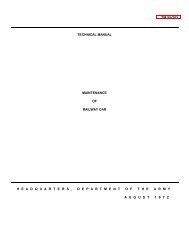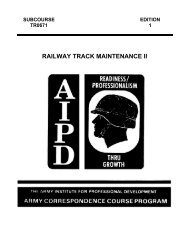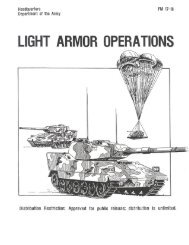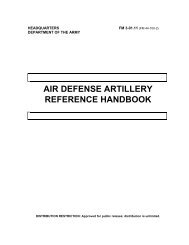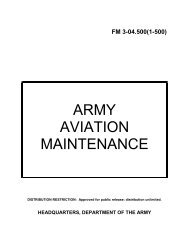fm 44-100 us army air and missile defense operations
fm 44-100 us army air and missile defense operations
fm 44-100 us army air and missile defense operations
Create successful ePaper yourself
Turn your PDF publications into a flip-book with our unique Google optimized e-Paper software.
FM <strong>44</strong>-<strong>100</strong><br />
AREA OF OPERATIONS<br />
A-5. The <strong>air</strong> area of <strong>operations</strong> is the area where the comm<strong>and</strong>er is assigned<br />
responsibility <strong>and</strong> authority for military <strong>operations</strong>. It <strong>us</strong>ually is, but does not<br />
necessarily need to be, identical to the ground area of <strong>operations</strong> in width <strong>and</strong><br />
depth. It extends vertically up to the maximum altitude of friendly ADA<br />
systems.<br />
BATTLESPACE<br />
A-2<br />
A-6. Battlespace is a physical volume that exp<strong>and</strong>s or contracts in relation to<br />
the ability to acquire <strong>and</strong> engage the threat. It varies in width, depth, <strong>and</strong><br />
height as the comm<strong>and</strong>er positions <strong>and</strong> moves assets over time. Battlespace<br />
is not assigned by a higher comm<strong>and</strong>er <strong>and</strong> can extend beyond the<br />
comm<strong>and</strong>er's area of <strong>operations</strong>.<br />
AREA OF INTEREST<br />
A-7. The area of interest is the geographic area <strong>and</strong> the <strong>air</strong>space above it<br />
from which information <strong>and</strong> intelligence are required to facilitate planning or<br />
successful conduct of the comm<strong>and</strong>er's operation. The ADA comm<strong>and</strong>er's area<br />
of interest is generally larger than the area of <strong>operations</strong> or battlespace due<br />
to the great distances that enemy <strong>air</strong> <strong>and</strong> <strong>missile</strong> systems can rapidly cover.<br />
The <strong>air</strong> area of interest will extend vertically to cover the maximum service<br />
ceilings or trajectories of <strong>air</strong>craft, UAVs, <strong>and</strong> <strong>missile</strong> systems. Horizontally, it<br />
will extend to cover the maximum range of <strong>air</strong>craft, UAVs, <strong>and</strong> <strong>missile</strong>s, pl<strong>us</strong><br />
enemy <strong>air</strong>fields, forward arming <strong>and</strong> refueling points, navigation aids, <strong>and</strong><br />
<strong>missile</strong> sites. The area of interest extends to the limits from which<br />
intelligence <strong>and</strong> information m<strong>us</strong>t be gathered about enemy forces that could<br />
affect friendly forces.<br />
DESCRIBE THE BATTLEFIELD’S EFFECTS<br />
A-8. The effects of terrain <strong>and</strong> weather on the enemy <strong>and</strong> friendly forces m<strong>us</strong>t<br />
be analyzed. They are different than the effects on ground <strong>operations</strong>.<br />
TERRAIN ANALYSIS<br />
A-9. Terrain analysis in support of <strong>air</strong> <strong>and</strong> <strong>missile</strong> <strong>defense</strong> is significantly<br />
different from terrain analysis for ground <strong>operations</strong>. The nature of <strong>air</strong>space<br />
does not eliminate the need for terrain analysis beca<strong>us</strong>e enemy <strong>air</strong> <strong>and</strong><br />
friendly ADA will still attempt to <strong>us</strong>e terrain to their own best advantage.<br />
IPB foc<strong>us</strong>es on the impact of geographic factors on the ability of enemy <strong>air</strong> to<br />
approach, acquire, <strong>and</strong> engage a target, or deliver <strong>air</strong>borne or <strong>air</strong> assault<br />
troops. Analysis of the terrain for <strong>air</strong> <strong>and</strong> <strong>missile</strong> <strong>defense</strong> follows the same<br />
principles as ground analysis <strong>and</strong> <strong>us</strong>es the military aspects of terrain:<br />
observation <strong>and</strong> fields of fire, cover <strong>and</strong> concealment, obstacles, key terrain,<br />
<strong>and</strong> avenues of approach (OCOKA).<br />
Observation <strong>and</strong> Fields of Fire<br />
A-10. These aspects relate to the influence of terrain on reconnaissance <strong>and</strong><br />
target acquisition. In the IPB context, observation relates to optical <strong>and</strong><br />
electronic line of sight. Many battlefield systems require line of sight to




